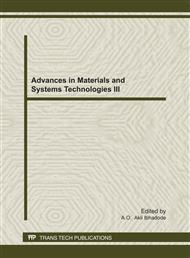[1]
J. J. Bowders, M. A. Usman, and J. S. Gidley: Stabilized fly ash for use as low permeability barrier. Geotechnical Practice for Waste Disposal; R.D. Woods Ed., GSP No. 13. ASCE New York p.320–333. (1987).
Google Scholar
[2]
T. Zimmie, H. Moo-Young, K.L. Plant: The use of waste paper sludge for landfill cover material. Green 1993 Waste disposal by landfill. An Int. symposium. Geotechnics related to environment, Bolton, Institute, U.K. USI 2: 11 – 19. (1993).
DOI: 10.1520/stp15647s
Google Scholar
[3]
T. Abichou, C. H. Benson, and G. T. Edil: Foundary green sand as hydraulic barriers laboratory studies. J. of Geotech and Geoenvironmental Engrg. A.S.C.E. Vol. 126. No. 12, (2000) p.1174–1183.
DOI: 10.1061/(asce)1090-0241(2000)126:12(1174)
Google Scholar
[4]
K. J. Osinubi and C. M. O. Nwaiwu: Hydraulic conductivity of compacted lateritic soil. Journal of Geotechnical and Geoenvironmental Engineering, ASCE, 131 No. 8 (2005), pp.1034-1041.
DOI: 10.1061/(asce)1090-0241(2005)131:8(1034)
Google Scholar
[5]
K. J. Osinubi and C. M.O. Nwaiwu: Design of compacted lateritic soil liners and covers. J. Geotech and Geoenviron. Engrg., ASCE, 132 (2), (2006), p.203 – 213.
DOI: 10.1061/(asce)1090-0241(2006)132:2(203)
Google Scholar
[6]
K. J. Osinubi, A. O. Eberemu and A. A. Amadi: Compacted Lateritic Soil Treated with Blast Furnaces Slag as Hydraulic Barriers in Waste Containment. Int. J. Risk Assessment and Management. Vol. 13, No. 2. (2009), p.177 – 188.
DOI: 10.1504/ijram.2009.030328
Google Scholar
[7]
D. E. Daniel, and C. H. Benson: Water content density criteria for compacted soil liners. ' J. of Geotechnical Engrg. A.S.C.E. Vol. 116. No. 12 (1990), pp.1811-1830.
DOI: 10.1061/(asce)0733-9410(1990)116:12(1811)
Google Scholar
[8]
D. E. Daniel: Clay liners. Geotechnical Practice for Waste Disposal' Edited by David E. Daniel. Chapman and Hall London. Pg. 137–163. (1993).
DOI: 10.1007/978-1-4615-3070-1_7
Google Scholar
[9]
S. Chiarakorn: Influence of Functional Silarus on Hydrophobicity of MCM. 41 Synthesized From Rice Husk. Sci. Technol. Adv. Mater 8, 110. (2007).
Google Scholar
[10]
AASHTO: Standard specification for transportation materials and methods of sampling and testing, 14th Ed., Washington, D.C. (1986).
Google Scholar
[11]
ASTM: Annual book of ASTM standards, Vol. 04. 08, Philadephia. (1992).
Google Scholar
[12]
British Standard Institute: Methods of testing soils for civil engineering purposes. BS 1377, London. (1990).
Google Scholar
[13]
K. H. Head: Manual of soil laboratory testing Soil classification and compaction tests. 2nd Ed. Vol. 1. Pentech Press, London. (1992).
Google Scholar
[14]
C. H. Benson, H. Zhai and X. Wang: Estimating hydraulic conductivity of compacted clay liners. J. Geotech. Engrg. ASCE, Vol 120 No. 2 (1994), p.366 – 387.
DOI: 10.1061/(asce)0733-9410(1994)120:2(366)
Google Scholar
[15]
K. J. Osinubi, A. O. Eberemu, and L. S. Kasham: Influence of bagasse ash content on the hydraulic conductivity of compacted lateritic soils at reduced Proctor effort Proceedings of Bi-Monthly Meetings/Workshops. Materials Society of Nigeria (MSN) Zaria Chapter. A.B.U. Zaria. pp.17-25. (2007).
DOI: 10.1061/41095(365)33
Google Scholar
[16]
T.W. Lambe: The structure of compacted clay. Journal of Soil Mechanics and Foundation Engineering Division, ASCE, Vol. 84, No. 2, (1958), pp.1-35.
Google Scholar
[17]
C. H. Benson, and D.E. Daniel: Influence of clods on hydraulic conductivity of compacted clay. J. of Geotech Engrg. A.S.C.E. Vol. 116. No. 8. (1990), p.1231–1248.
DOI: 10.1061/(asce)0733-9410(1990)116:8(1231)
Google Scholar
[18]
H. W. Olsen,: Hydraulic Flow Through Saturated Clays". Proceedings of the Ninth National Conference on Clays and Clay Minerals. (1962), pp.131-161.
DOI: 10.1016/b978-1-4831-9842-2.50011-0
Google Scholar
[19]
K. J. Osinubi and O. A Eberemu.: Hydraulic conductivity of compacted lateritic soil treated with blast furnace slag. Electronic Journal of Geotechnical Engineering (EJGE) Vol. 11, (2006) – Bundle D. Paper 0693.
DOI: 10.1007/s10706-010-9308-6
Google Scholar
[20]
K. J. Osinubi, A. O. Eberemu and A. Ogbe: Effect of bagasse ash content on the hydraulic properties of lateritic soil. Submitted to Nigerian Journal of Material Science and Engineering (NJMSE) Vol. 1, No. 1. (2008), p.53 – 62.
Google Scholar


